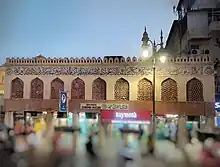| Sunehri Masjid (Chandni Chowk) | |
|---|---|
 Sunehri Masjid at Chandni Chowk, old Delhi | |
| Religion | |
| Affiliation | Islam |
| District | Central Delhi |
| Status | Active |
| Location | |
| Location | Delhi |
| Country | India |
 Shown within Delhi  Sunehri Masjid (Chandni Chowk) (India) | |
| Territory | Delhi |
| Geographic coordinates | 28°39′22″N 77°13′55″E / 28.656050°N 77.231887°E |
| Architecture | |
| Type | Mosque |
| Style | Mughal |
| Completed | 1722 |
| Dome(s) | 3 |
The Sunehri Masjid (lit. 'Golden Mosque') is an 18th-century mosque in Old Delhi. It was built by Mughal noble Roshan-ud-Daula, during the reign of Mughal Emperor Muhammad Shah. It is located near the Gurudwara Sis Ganj Sahib in Chandni Chowk, once an imperial boulevard leading to the Red Fort.
The mosque's original appearance has been altered as extensions to accommodate the faithful have been constructed. The mosque is also under threat from encroachment.
History

The Sunehri Masjid was built in the period 1721-1722 by Roshan-ud-Daula, a Mughal amir who was beginning to rise to power in the court of the Mughal Emperor Muhammad Shah. The mosque was dedicated to Roshan-ud-Daula's spiritual mentor, Shah Bhik.[1]

In 1739, the Persian Nadir Shah invaded Delhi. Standing in the Sunehri Masjid, he ordered the plunder of Delhi, which resulted in an immense loss of life and damage to the city.[2]
In 1897, Islamic scholar Amin al-Din established Madrasa Aminia at the Sunehri Masjid, later on shifting it to Kashmiri Gate in 1917.[3]
Architecture
Elevated above street level on a plinth, the Sunehri Masjid is reached by a flight of stairs. The mosque is topped by three bulbous, gilted domes, and features slender minarets. The facade of the mosque bears three arched entryways. The interior of the mosque is divided into three bays. Stucco decoration work appears in both the interior and exterior of the mosque, in the form of arabesques and floral motifs.[1][4]
References
- 1 2 B., Asher, Catherine (1992). Architecture of Mughal India. Cambridge Univ. Pr. pp. 295–298. ISBN 0-521-26728-5. OCLC 260144059.
{{cite book}}: CS1 maint: multiple names: authors list (link) - ↑ B., Asher, Catherine (1992). Architecture of Mughal India. Cambridge Univ. Pr. p. 301. ISBN 0-521-26728-5. OCLC 260144059.
{{cite book}}: CS1 maint: multiple names: authors list (link) - ↑ Jhabvala, C. S. H. (24 May 2012). Delhi: Phoenix City. Penguin Books India. ISBN 9788184754919.
- ↑ Alfieri, Bianca Maria (2000). Islamic Architecture of the Indian Subcontinent. Lawrence King Publishing. p. 276. ISBN 9781856691895.
External links
![]() Media related to Sunehri Masjid (Chandni Chowk) at Wikimedia Commons
Media related to Sunehri Masjid (Chandni Chowk) at Wikimedia Commons